#029
From Basic Research
to Business Applications
Making Meteorology
More User-Friendly
Yoshiaki Miyamoto
Japanese Color: KIKUCHIBA-iro
#029
Yoshiaki Miyamoto
Japanese Color: KIKUCHIBA-iro
MOVIE

Assistant professor
Faculty of Environment and Information Studies
It seems like every year Japan suffers immense damage from typhoons that make landfall. The mechanisms of these typhoons mostly remain a mystery. However, in 2018, a research team led by the assistant professor Yoshiaki Miyamoto discovered a new theory to elucidate the mechanisms that form an “outer eyewall cloud”, which cause sudden changes to the structure and strength of a typhoon. It is anticipated this theory will remarkably improve the accuracy in estimating how strong a typhoon will become. Assistant professor Miyamoto is also actively working on projects aimed at finding applications for meteorology in society and business.
Inside a developed typhoon is the cloudless “eye” near the center, and the ring-shaped cloud of the “eyewall cloud” that surrounds the eye. Water vapor drawn up from the sea collect and condense (into water droplets) in the eyewall cloud, and this keeps the typhoon rotating. So the eyewall cloud is the so-called “engine” propelling the typhoon, and the amount of condensation within it affects the structure and strength of a typhoon.
Another collection of ring-shaped clouds called the “outer eyewall cloud” can suddenly form outside the eyewall cloud in strong typhoons. Once formed, this outer eyewall cloud rapidly grows in size, and in around 20 to 30 hours it replaces the original eyewall cloud to become a “new eyewall cloud”; this is also when the typhoon’s structure and strength drastically changes. It basically becomes a completely new typhoon, and such dramatic changes make it extremely difficult to predict the typhoon’s strength.
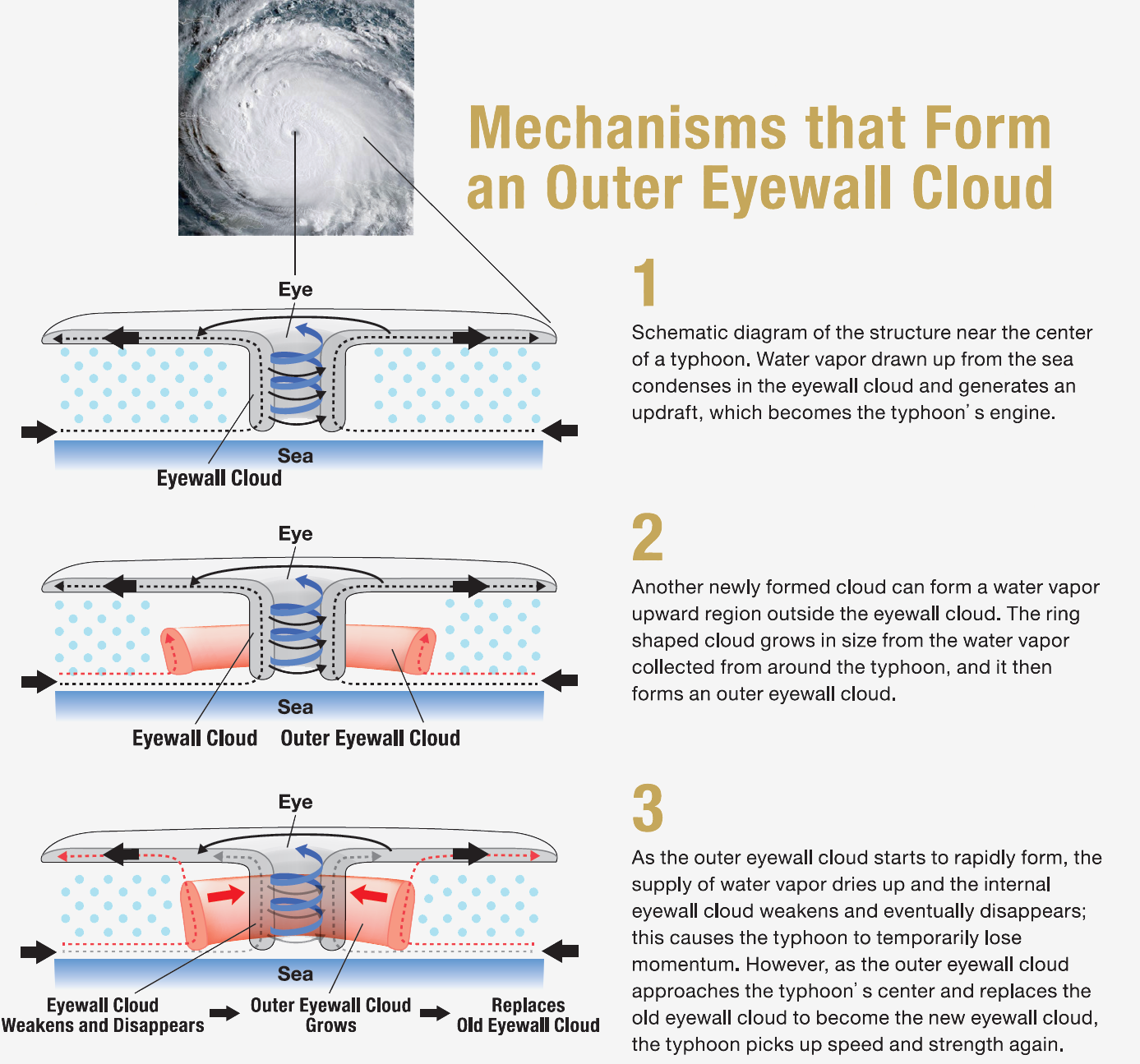
This is why, particularly in the past decade, many preeminent researchers of typhoons have been working on clarifying the mechanisms behind the formation of an outer eyewall cloud. Although over 20 theories have been proposed, so far none of them have elucidated the mechanisms.
Our research team has successfully revealed the mechanisms behind this phenomenon, which has remained a mystery for many years. We were the first researchers in the world to establish a theory that can predict when and where an outer eyewall cloud will form. It is anticipated this theory will remarkably improve the accuracy in estimating how strong a typhoon will become.
We used this theory to estimate the formation placement and timing of an outer eyewall cloud, and we were able to get almost identical matches with the existing values observed in actual typhoons. We also ran computer simulations of typhoons and found it is possible to predict when an outer eyewall cloud can form several hours before it actually does.
Our theory on the mechanisms that form of an outer eyewall cloud has been developed from the Ekman theory of basic meteorology.
Swirling the surface of water will create a whirlpool, and stopping the movement will make it naturally disappear; the Ekman theory explains why the whirlpool disappears. This is why the Ekman theory normally describes why a typhoon moves in a direction that weakens its momentum.
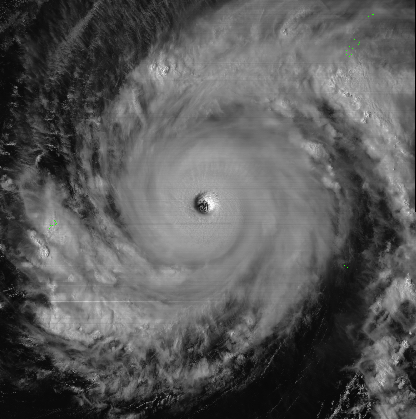
However, we discovered the reverse to be true; if a typhoon’s wind distribution meets certain conditions, the Ekman theory explain why the outer eyewall cloud updraft grows and moves the typhoon in a direction that strengthens its momentum. Specifically, the updraft can grow if the following two conditions are met: 1. A typhoon slowly weakens as the wind becomes quite stronger and moves away from the center, and 2. 1. Occurs at a distance of 2 to 7 times the eye’s radius. So when the eyewall cloud’s radius is around 30 to 50km, and an outer eyewall cloud can form at a radius of 100 to 150km from the eye, then it’s possible to predict its sudden formation.
Predicting the course of a typhoon has improved over the years thanks to access to ample observation data obtained from artificial satellites, advances in computer technology, and improved weather forecasting models. Yet there has been virtually no progress in the accuracy of predicting a typhoon’s strength in the past several decades. Our recent finding significantly contributes to improving this accuracy, and it is also a tremendous discovery in terms of potentially unravelling one of the main mysteries of typhoons.
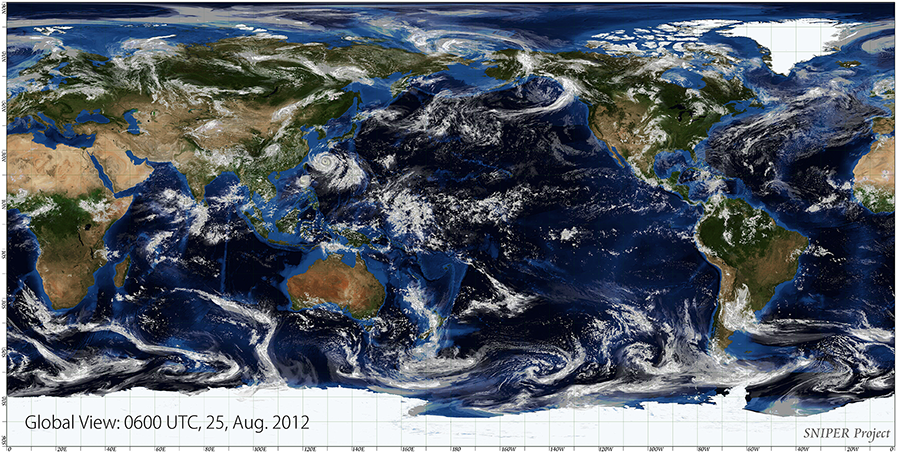
The Ekman theory is common knowledge among meteorologists. Yet ever since it was proposed at the start of the 20th Century, it has been primarily considered as the “theory to explain how a whirlpool weakens”; this is why so far no researcher has thought to apply the Ekman theory to clarify the mechanisms that cause a typhoon to become stronger (outer eyewall cloud).
Although it was a flash of insight that led our team to apply the Ekman theory to understand these mechanisms, we would endeavour to be flexible in our thinking every day, and “not follow an orthodox approach” to our research. I believe this is what enabled us to make such a substantial finding.
Moreover, in contrast to the majority of previous research that mostly proposed theories by observing phenomena and using data to support the obtained forecasts, our theory can be expressed as a formula. I believe this makes it an almost universal theory.
By detecting the signs that indicate an outer eyewall cloud will form and applying our formula, meteorologists can now predict how many hours later an outer eyewall cloud will form, and how many kilometers from the eye it will be situated. We are planning to continue our research to discover what it is that generates those signs.
Meteorology is an intricate aspect of people’s daily life; it is used to forecast the weather, study global warming, and measure air pollution, among other uses. Meteorology in Japan is very much connected with what’s happening on the ground when it comes to weather forecasts and disasters; yet there has hardly been any progress in finding business applications for meteorology. So in 2017, the industry, government and academia in Japan came together to set up the Weather Business Consortium (WXBC) to facilitate the application of weather data and other weather-related information in business. I am also a member of this consortium as an expert on weather, and through the WXBC I have been holding workshops and carrying out joint studies with companies.
The potential business applications of meteorology are expanding to encompass a diversity of industries, from agriculture and clothing to finance. Recently there has also been a surge in the development of applications using weather data, such as those that suggest outfits for the day based on forecasts of the chance of rain, temperature, humidity, and other data.
The Japanese Meteorological Agency (JMA) has accumulated a vast amount of weather observation and forecast data (called “big data”). However, this data is difficult to understand and handle for the average company, and it is safe to say the data hasn’t been used effectively so far. I believe meteorological researchers, such as myself and my team, need to work with the WXBC and similar organizations and provide companies with ways to read, understand and handle weather data. This is how we can stop such data from being nothing more than a useless treasure.
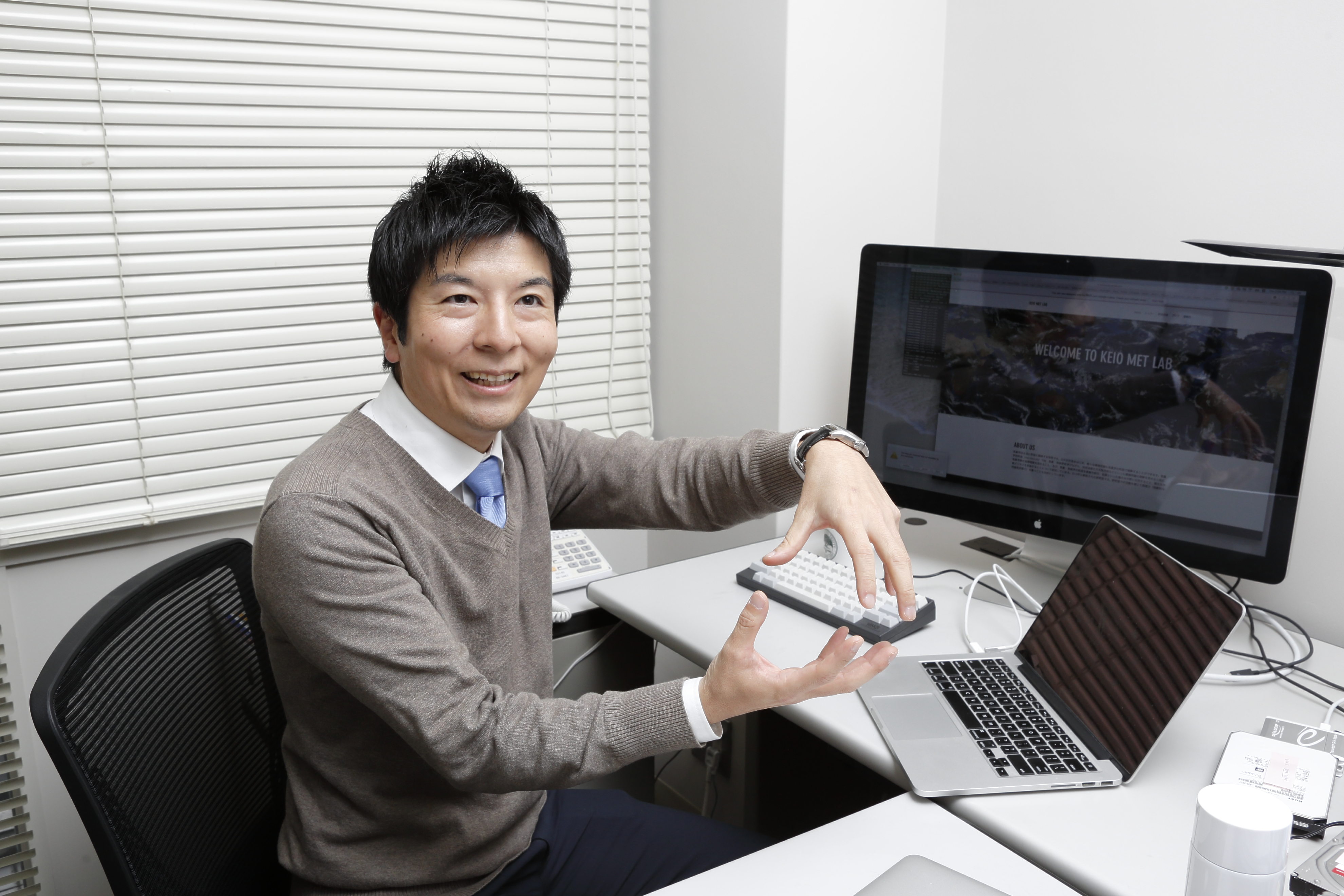
Meteorology research consists mostly of basic research at Japanese universities. However, some Western universities also offer Applied Meteorology and other such courses, which I believe have immense potential for applications in business. With its research staff who are working in the front-line of a diversity of fields, the SFC is the ideal environment to research applications for extensive weather data. The SFC Urban Nexus Lab (UNL) is shining a light on the food, energy and water that are essential for human life, and looking at how global warming will affect these vital resources. The UNL is researching this and other areas through international collaborations, and in joint studies with professors in other fields such as architecture.
There are also some students in my lab who have come up with unique ideas for business applications. One student is developing an application to predict the crowdedness of the buses that many students use to travel to the university. The buses are particularly crowded on rainy days, so the application combines data on the forecast of rain around the campus and the bus timetable to predict how crowded the buses will be. One of my goals from here on is to work earnestly with meteorology students to research such business applications for weather data, and eventually provide this information to companies and work with them on joint projects.
In addition to creating products such as these applications, I will also focus on training talented graduates who can connect weather data with companies. I’d like to continue working with many researchers and students at the SFC as our base, and keep supporting the development of business applications of meteorology.
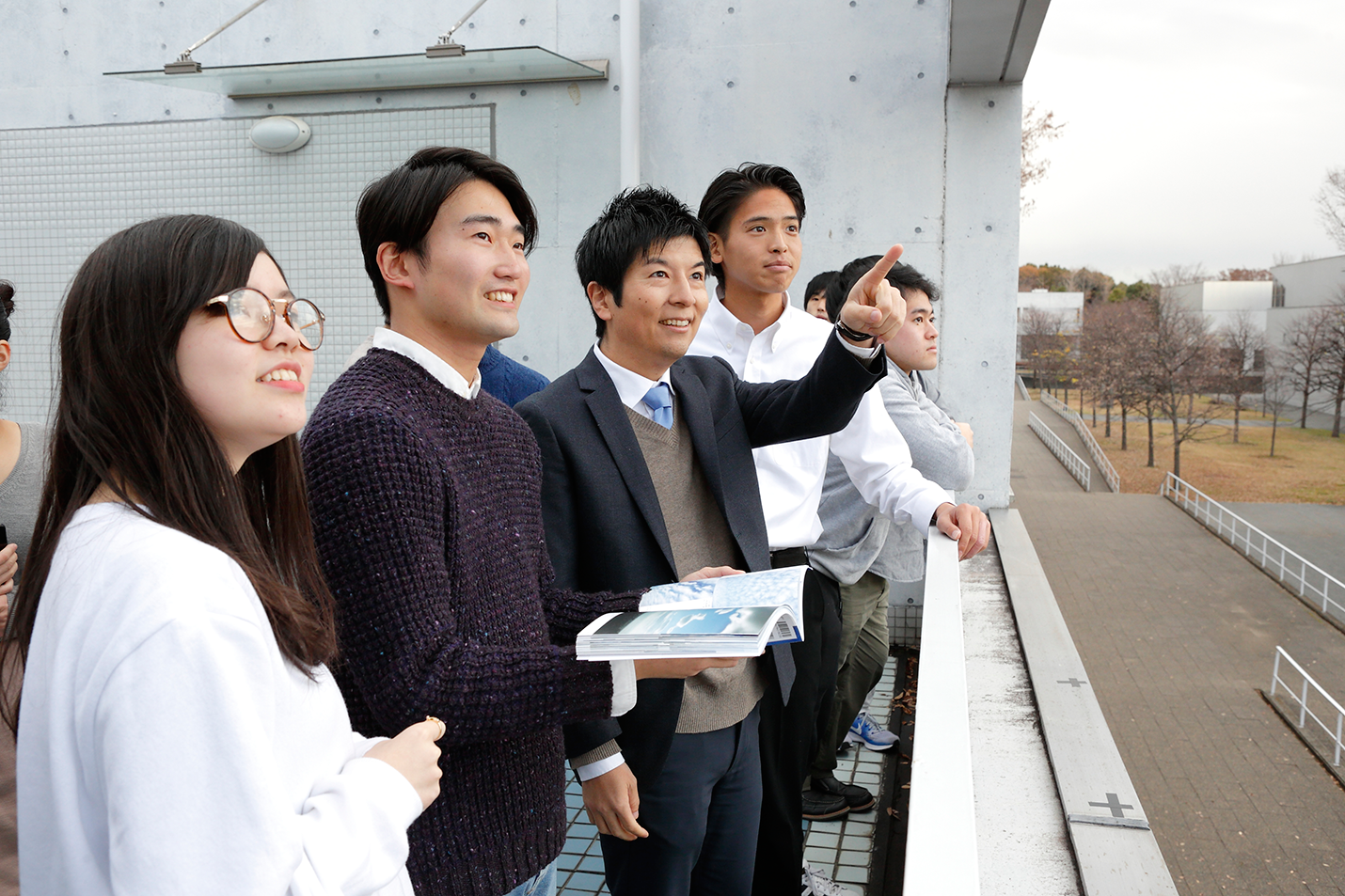
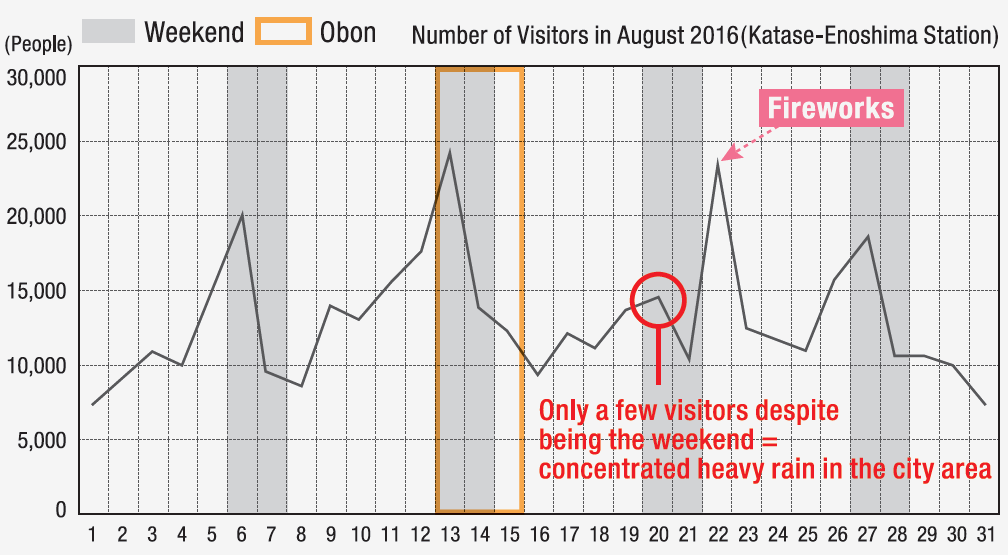
This graph is part of the research being carried out by students at Assistant Professor Miyamoto’s lab. It shows the effect of the weather on the number of tourists to the Enoshima area. In addition to basic research, the students at this lab are researching a diverse range of themes on the applications of meteorology, such as this study on the weather and Enoshima.
These themes include the meteorological fields that cause meteorotropic diseases, how changes in the weather affect women’s skin, and developing temperature-indexed financial products and a “touchable” weather forecast system.

Yoshiaki Miyamoto
Assistant professor, Faculty of Environment and Information Studies, Keio University. Completed the Doctoral Program for Earth and Planetary Science at Graduate School of Science, Kyoto University. After working as a Special Postdoc Researcher in Basic Science at the RIKEN Advanced Institute for Computational Science (R-CCS) and completing an Overseas Research Fellowship at the Japan Society for the Promotion of Science (JSPS), he assumed his current position at Keio University in 2018. Ph.D. (Science). Specializes in Meteorology.

2019.Mar ISSUE